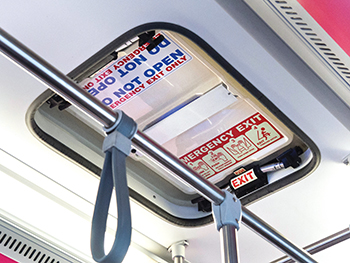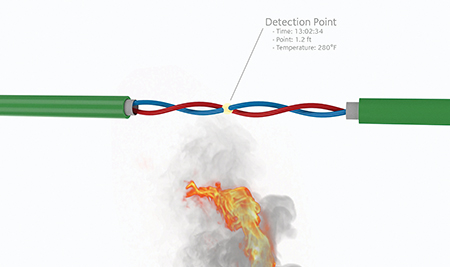
By Joseph Peoples
With the rapid introduction and adoption of all-electric vehicles in the transit market, it is critical that agencies and operators are educated on the fire risks associated with new bus builds and technologies. Without proper training and knowledge, there are several major fire risks which agencies might miss.
Assessing Fire Risk Management
Your management policy should reflect the highest level of safety. The ultimate goal is to minimize bus fire risks, monitor the effectiveness of safety risk controls, and to meet or exceed safety objectives.
The maintenance team should be aware of the root causes of fires, conducting risk assessments, and formulating best practices for safety.
Manufacturers should ensure new products and manufacturing methods reduce the risks to the best extent possible.
Performing a fire risk assessments outlines the level of risk posed by a fire hazard and the assessment of the likelihood of harm, firstly to people, but also to property and business continuity.
 Identify Fire Hazard Areas
Identify Fire Hazard Areas
A fire hazard area is any compartment or space that contains both an ignition source and flammable/combustible material.
Engine compartments and battery compartments are known hazards in which fire have occurred.
Identifying Fire Risks Within the Hazards
Within the fire hazard an assessment is made by identifying the likelihood of flammable fluids or combustible igniting on a hot surface and arching/shorting of electrical cables.
The risk is determined based on the known failure modes which have been shown to result in fires.
• Heat Degradation of combustible materials in close proximity to high heat sources
• Components that are operated at or near their maximum specified duty cycles, temperatures etc.
• Abrasion or other mechanical damage
• Maintenance issues
• Risks introduced during manufacturing of the bus
It is crucial to understand the risks in terms of flame spread, smoke, and toxic gas generation.
Plastics – Plastic material is a compound of polymer plus additives which has the capabilities of being shaped or molded into a valuable product. Common plastics found on transit buses include air cleaners, reservoirs for flammable liquids, fan cowling, wheelwell liners, insulation for components like battery cables., and in the vehicle’s trim itself.
There are two types of plastics:
Thermoplastics tend to soften and flow at high temperatures, often before ignition takes place.
Thermosetting materials do not soften but undergo localized surface charring (sometimes with flaming), and the charred residue can either fall off or remain in place to form an insulating layer.
Plastics containing carbon and hydrogen monomers can be highly flammable and, once they ignite, they produce flammable gases that can fuel a fire further.
Plastics which are composed of carbon, hydrogen, and oxygen burn slower than the others mentioned.
For plastics which contain halogens (less combustible than other plastics), a flame must be continuous or the plastic will self-extinguish.
Plastics as a group generally have higher ignition temperatures than wood. However, almost all plastics can be made flame- or smoke-retardant by adding other chemicals during manufacturing.
Plastics have been reported to have very high flame spread characteristics, as high as 2 feet per second, or 10 times that of wood on the surface. Because of their ability to melt and run, plastics can spread fires in ways that could mislead fire investigators.
Heated/burning plastics may produce large quantities of thick, black smoke – or even toxic gas.

Mitigation/Control Methods
Training – Increase awareness of fires at your operation and increase the general concern level of your employees. This is a matter of creating a well-informed interest in fire risks and making sure everyone has the knowledge needed to assess these risks.
Operators should have knowledge of early fire indicators. There should be briefings for passengers on bus fires, and on emergency evacuation procedures.
Dispatchers should practice procedures related to fire responses, using 911-style flipcards if necessary.
Fire Detection and Suppression
Fire suppression technology should focus on fast detection with minimal nuisance alarms. The system should have a sufficient quantity of extinguishing agent and nozzles. Furthermore, it should protect against re-ignition (a deadly concern in the case of electric vehicle fires) and be effective during all operation modes. Componentry should withstand harsh environments in a bus application, and techs should be cognizant of required preventive maintenance.
The goal of any fire suppression system is to provide as much evacuation time for the driver and passengers – not to fully extinguish a major vehicle fire. Keep the fire contained, keep it from spreading, and get everyone off the bus so the fire department can arrive and do their job.
Know Fire Risks and Lessons Learned
Battery Compartment
There are numerous considerations to be made in the vehicle’s battery compartment. Firstly, there should be no exposed threads from bolts causing a fire risk. Opening and closing the battery compartment should not cause undue stress or rubbing of battery cables.
Connections at the battery should minimize incorrect connections during maintenance, and battery hold-down clamps should be made of non-conductive material or isolated from the chassis.
High Current Electrical Cables (battery)
• Insulation Flammability Characteristics
• Resistance to chemicals and abrasion
• Flexing
Battery cables are constructed of a single-conductor bare copper cable. In cold weather, these cables can become very stiff and difficult to work with. This is due to their already-limited flexibility.
Though they provide resistance against heat/fire and abrasion, they are usually less flexible than other types of cable. This is because the battery cables have thicker copper strands which are not as compact as other cables.
Welding wire is typically used because of its flexibility and versatility, thanks to its construction of finer strands of copper and ethylene-propylene diene monomer (EPDM) or neoprene rubber jacket which also acts as insulation. In fact, welding wire is generally more flexible than regular electrical wires or power cables. These cables meet UL-1581 flame-resistant standards.
EPDM is a flammable material with a very low limiting oxygen index (LOI) value. EPDM polymer doesn’t contain halogens within the polymer chain and is not inherently fire resistant. Thus EPDM, being purely hydrocarbon, can easily catch fire. It burns easily, causing rapid fire spread and the emission of high amounts of dense smoke. This presents a fire risk of which operators must remain cognizant.
New product considerations must be made for high-current electrical cables on electric vehicles, including insulation flammability characteristics and resistance to chemicals and abrasion.
DAFO is a global company specializing in fire risk mitigation and advanced fire detection and suppression technologies for over the road and off-road vehicles.
Our patented intelligent detection wire is is guaranteed against false alarms from shorts, abrasion, and other damage. The detector will only alarm when it’s set alarm temperature is reached. The location of the alarm point is logged to facilitate in location of origin of the heat source.

Our air bag inflation-based extinguisher eliminates the common issues of leakage and scheduled maintenance and re-certification.
 The system provides full backup power capabilities without the need to replace batteries.
The system provides full backup power capabilities without the need to replace batteries.
All faults, alarms, inputs, and outputs are logged and can be accessed even with loss of power.
J 1939 CANBUS communication allows for easy integration into vehicle systems and allows for easy location and monitoring or our canbus sensors.
DAFO systems are chosen as standard factory fit from numerous OEMs.
Joseph Peoples has been in the fire protection industry for 40 years and has worked both military and commercial projects. The past 30 years has been dedicated to the transit industry. After 20+ years with one of the leading suppliers of fire protection systems for buses he focused his efforts working as a consultant on the research and preventative side. He is an acknowledged expert in bud fire investigations and risk management. Visit https://dafoamericas.com/ for more information.
